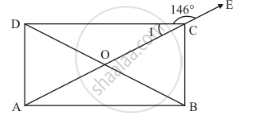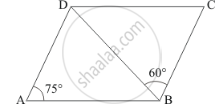Advertisements
Advertisements
Question
In the given figure, ABCD is a rectangle in which diagonal AC is produced to E. If ∠ECD = 146°, find ∠AOB.
Solution
ABCD is a rectangle
With diagonal AC produced to point E.

We have
∠1 + ∠DCE = 180° (Linear pair)
∠1 + 146° = 180°
∠1 = 34°
We know that the diagonals of a parallelogram bisect each other.
Thus OC = OD
Also, angles opposite to equal sides are equal.
Therefore,
∠ODC = 34°
By angle sum property of a traingle
∠ODC +∠1 + COD = 180°
34° + 34° CPD = 180°
68° +∠COD = 180°
∠COD = 112°
Also, ∠CODand ∠AOB are vertically opposite angles.
Therefore, ∠AOB = 112°
Hence, the required measure for ∠AOBis 112°.
APPEARS IN
RELATED QUESTIONS
Three angles of a quadrilateral are respectively equal to 110°, 50° and 40°. Find its fourth angle
The angles of a quadrilateral are in the ratio 3 : 5 : 9 : 13 Find all the angles of the quadrilateral.
Two opposite angles of a parallelogram are (3x – 2)° and (50 – x)°. Find the measure of each angle of the parallelogram .
In Fig. below, ABCD is a parallelogram in which ∠DAB = 75° and ∠DBC = 60°. Compute
∠CDB and ∠ADB.

If an angle of a parallelogram is two-third of its adjacent angle, the smallest angle of the parallelogram is
The diagonals AC and BD of a rectangle ABCD intersect each other at P. If ∠ABD = 50°, then ∠DPC =
One angle of a quadrilateral is of 108º and the remaining three angles are equal. Find each of the three equal angles.
If three angles of a quadrilateral are each equal to 75°, the fourth angle is ______.
The sum of all ______ of a quadrilateral is 360°.
In a quadrilateral PQRS, ∠P = 50°, ∠Q = 50°, ∠R = 60°. Find ∠S. Is this quadrilateral convex or concave?
